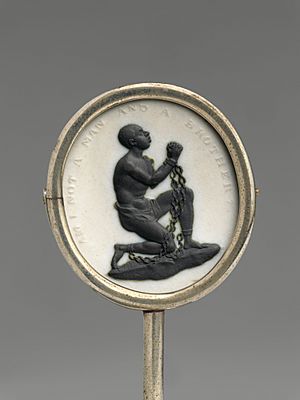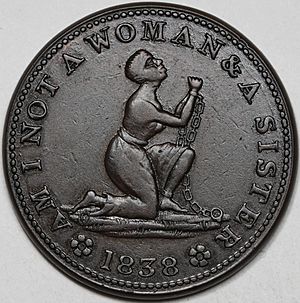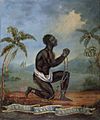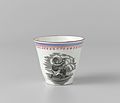Wedgwood anti-slavery medallion facts for kids

The Wedgwood anti-slavery medallion was a special symbol created in 1787. It was made by a famous British potter named Josiah Wedgwood. This medallion was used by the Society for the Abolition of the Slave Trade. This group worked to end slavery.
The medallion shows a Black man kneeling in chains. His hands are raised, and it says, "Am I not a man and a brother?" This powerful image was designed by Henry Webber and William Hackwood. Wedgwood's factory made these medallions from a material called jasperware. People wore them as necklaces, put them on snuff boxes, or used them on bracelets and hairpins. They quickly became a popular symbol for the movement to end slavery in Britain. The medallion helped a lot to spread the message against slavery. Today, it is known as one of the most famous anti-slavery items ever made.
How the Medallion Began
In 1787, the Society for Effecting the Abolition of the Slave Trade decided they needed a clear symbol. They asked Josiah Wedgwood for help. On October 16, 1787, a design by Henry Webber was shown to the Society. Wedgwood was very involved in the project. So, he likely helped shape the final design.
Webber's design showed a Black man who was enslaved, kneeling down. The words "Am I not a man and a brother?" were with him. This design was first a print. Then, it was turned into a sculpture, probably by William Hackwood.
How the Medallion Spread
By the end of 1787, Wedgwood started making the medallion at his factory. It is not known exactly how many were made. But many people wanted them. For example, the Society gave out over 15,000 copies of a pamphlet by Thomas Clarkson. It is thought that the demand for the medallions was just as high.
The medallions were given out through the Society's network. Wedgwood sent many to Thomas Clarkson in Britain. He also sent them to Benjamin Franklin in the United States. Historians believe Wedgwood paid for making and giving out the medallions himself. Similar items were sold for about three guineas, which was a lot of money back then.
Wedgwood's anti-slavery medallions were put on many different items. These included snuff boxes, shoe buckles, bracelets, and hairpins. These items were sold in Britain and the United States. Hundreds of people who supported the movement bought them. Many of these buyers were middle-class women. This helped make the anti-slavery movement more popular and fashionable.
The Medallion's Impact
In 1828, a new version of the medallion appeared. It showed a kneeling enslaved woman. The words were "Am I not a woman and a sister." This version was made to highlight the struggles of enslaved women. George Bourne's 1837 book, Slavery Illustrated, featured this female version.
The American anti-slavery newspaper The Liberator also used the kneeling slave figure. It was part of the newspaper's title design. This was likely created by Hammatt Billings.
In 1968, African American men protested during the Memphis sanitation strike. They carried signs that said, "I AM A MAN". Many people believe this slogan came from the Wedgwood medallion. As Cecelia M. Hartsell wrote, the phrase "Am I Not a Man and A Brother" changed. It was no longer a question. It became a strong statement of identity.
Gallery
-
A French version made in 1789 in Sèvres
-
A painting from around 1800 at Wilberforce House
-
An 1835 poster by John Greenleaf Whittier with the symbol
-
A diorama of the Memphis sanitation strike showing the "I AM A MAN" signs
See also
- Representation of slavery in European art
- Emancipation Memorial
- Ain't I a Woman?
- I Am a Man!









